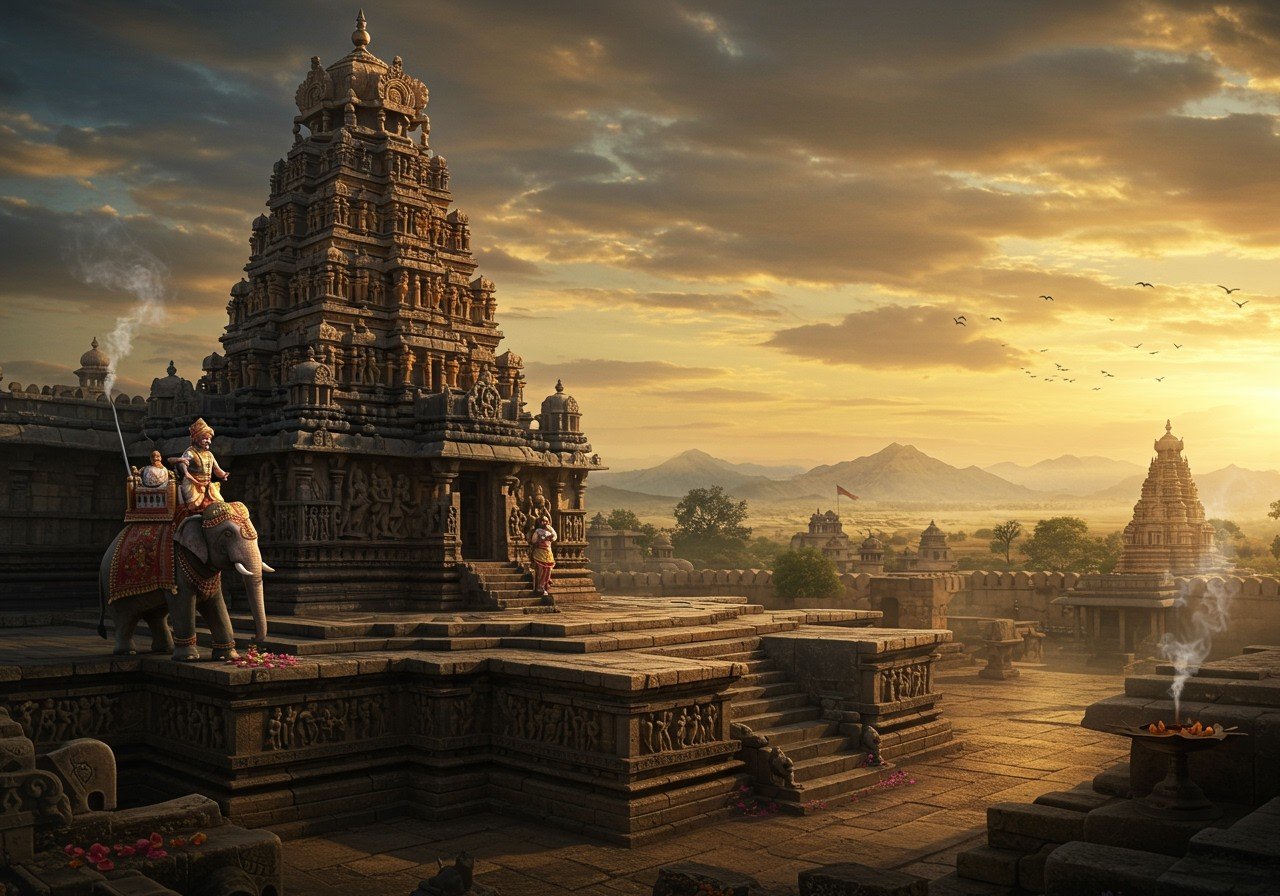
The Hoysala Empire, a significant power in South India, thrived from the 10th to the 14th centuries CE. Exploring their cultural, architectural, and political achievements offers valuable insights into Karnataka’s rich heritage. This blog delves into the complete history of the Hoysala Empire—its rise, peak, and eventual decline.
Origins and Early History (10th-11th Centuries)
The Hoysala dynasty originated in the Malenadu region, with Nripa Kama as its founder. The name “Hoysala” comes from the legendary tale of Sala slaying a tiger at his guru’s instruction. Initially, they were local chieftains under the Western Chalukyan Emperors. These early Hoysalas faced constant challenges from neighboring powers like the Cholas and Chalukyas.
- Capital Cities: Initially established in Belur, the capital later shifted to Halebidu. These strategic locations facilitated trade and offered military advantages.
- Early Rulers: Focused on consolidating their power and expanding their territories through strategic alliances and military campaigns.
- Socio-Political Structure: The Hoysalas implemented a feudal system supported by an efficient administration that helped maintain order and collect taxes.
- Religious Affiliations: While early Hoysalas patronized Jainism, later rulers embraced Hinduism, leading to the construction of magnificent temples dedicated to Hindu deities.
- Architectural Innovations: The foundations of the distinctive Hoysala architectural style were laid during this period, characterized by intricate carvings and the use of soapstone.
Expansion and Zenith (12th-13th Centuries)
The Hoysala Empire reached its zenith under the rule of King Vishnuvardhana (1108-1152 CE). This period witnessed significant territorial expansion, including the annexation of Gangavadi and Nolambavadi, and remarkable cultural growth.
- Military Campaigns: Vishnuvardhana led successful campaigns against the Cholas and other rivals, significantly expanding the empire’s territories and solidifying Hoysala power.
- Administrative Reforms: New administrative measures were introduced to effectively manage the expanded territories and ensure efficient governance.
- Key Temples: This era saw the construction of architectural marvels like the Chennakesava Temple at Belur, a prime example of the evolving Hoysala style. Explore similar temples and their significance on Poojn.in.
- Queen Shantala Devi: A notable figure, Queen Shantala Devi, known for her patronage of Jainism and her contributions to the empire’s cultural richness.
- Economic Prosperity: Agriculture, trade, and commerce flourished, contributing to the empire’s economic stability and prosperity.
- Literary Achievements: Kannada and Sanskrit literature thrived under royal patronage, with renowned poets like Raghavanka and Harihara contributing to the literary landscape.
- Diplomatic Relations: The Hoysalas maintained diplomatic ties with other powerful dynasties like the Chalukyas and Pandyas, fostering peaceful coexistence and strategic alliances.
Architectural Marvels (11th-13th Centuries)
The Hoysala Empire is renowned for its unique architectural style, characterized by intricate carvings, detailed sculptures, and the innovative use of soapstone.
- Dravidian Influence: The Hoysala style evolved from the Dravidian architectural tradition, but with distinctive features like star-shaped temple plans and elaborate ornamentation.
- Key Temples: The Hoysaleswara Temple at Halebidu and the Kesava Temple at Somanathapura are prime examples of Hoysala architectural ingenuity. Discover more about ancient temple architecture on Poojn.in.
- Soapstone Use: The use of soapstone, a relatively soft stone, allowed for incredibly detailed carvings and contributed to the temples’ durability.
- Sculpture Themes: The sculptures adorning the temples depict mythological stories, floral motifs, scenes from daily life, and depictions of deities, showcasing the rich cultural tapestry of the time.
- Skilled Artisans: Highly skilled artisans played a crucial role in creating these architectural masterpieces, their expertise evident in the intricate details and precision of the carvings.
- Influence on Later Designs: The Hoysala architectural style significantly influenced later temple designs in South India, leaving a lasting impact on the region’s architectural heritage.
Decline and Legacy (14th Century Onwards)
The decline of the Hoysala Empire began in the late 13th century due to a combination of internal strife and external pressures.
- Succession Disputes and Weak Leadership: Internal conflicts and weak leadership following the death of Ballala III created instability and weakened the empire from within.
- Delhi Sultanate Invasions: Repeated invasions by the Delhi Sultanate, particularly the raids led by Malik Kafur, significantly weakened the Hoysalas and plundered their wealth.
- Rise of Vijayanagara: The emergence of the Vijayanagara Empire further contributed to the decline of the Hoysalas, as they lost territories and influence to this rising power.
Cultural Contributions and Lasting Impact
Despite its decline, the Hoysala Empire left a lasting legacy through its significant contributions to South Indian culture.
- Religious Harmony: Jainism and Hinduism coexisted peacefully under Hoysala rule, fostering a climate of religious tolerance and cultural exchange.
- Literary Flourishing: Kannada literature flourished during this period, with prominent poets and writers contributing to the rich literary tradition of the region. You can find products related to literature and culture at poojn.in.
- Artistic and Architectural Achievements: The Hoysala temples and sculptures stand as testaments to their exceptional artistic and architectural skills, inspiring awe and admiration even today. Consider enhancing your spiritual experience with sacred items from Poojn.in.
The Hoysala Empire remains a cherished part of Karnataka’s heritage. Their architectural marvels, cultural contributions, and efficient governance continue to inspire and intrigue. Explore the rich history of this era and connect with India’s cultural heritage through authentic puja items available at Poojn.in.


